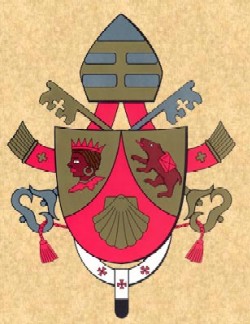Benedict XVI's Coat of Arms
 The coat
of arms of Pope Benedict XVI incorporates both papal elements, as well as the elements of the coat
of arms he bore as Archbishop of München (Munich) and Freising, and as the Prefect of the
Congregation for the Doctrine of the Faith.
The coat
of arms of Pope Benedict XVI incorporates both papal elements, as well as the elements of the coat
of arms he bore as Archbishop of München (Munich) and Freising, and as the Prefect of the
Congregation for the Doctrine of the Faith.
Miter. The miter replaces the "beehive" tiara familiar from former papal coats of arms. Pope Paul VI dropped the ceremonial use of the tiara, although he, and his immediate successors John Paul I and John Paul II, retained it in their coats of arms. Benedict XVI has replaced it with the miter, on which is emblazoned three gold bands representing "order, jurisdiction and magisterium."
These are the symbolic equivalents of the three layers of the tiara. They are connected into a unity by the vertical gold strip, representing the unity of these three kinds of authority in the person of the Supreme Pontiff.
Pallium. The use of the white pallium with red crosses draped below the shield is a new addition to papal coats of arms. It represents episcopal authority, the special kind of jurisdiction that is reserved to metropolitan archbishops in their province and to the pope universally in the Church, what is called the plenitudo pontificalis officii (i.e. the plenitude of pontifical office). The style of pallium shown on the coat of arms, with either red or black crosses on a narrow band of wool, is what is commonly known from the second millennium. At his inaugural Mass, Pope Benedict wore an older style of pallium, broad with red crosses, and hanging down from the left shoulder rather than in the middle. This style is more typical of the first millennium, and similar to the omophorion representing episcopal authority in the Eastern Church.
Crossed Keys. The two crossed keys symbolize the powers Christ gave to the Apostle Peter and to his successors.
I will give you the keys to the kingdom of heaven. Whatever you bind on earth shall be bound in
heaven; and whatever you loose on earth shall be loosed in heaven." (Matthew 16:19)
The gold key represents the power to bind in heaven and the silver key spiritual authority on earth. The two keys are united by the cord, again indicating their essential unity in Peter and his successors.
Caput Aethiopum. According to the website of his former Archdiocese:
"The shield, which is divided into three sections, displays the “Moor of Freising." The Moor’s head, facing left and typically crowned, appeared on the coat of arms of the old principality of Freising as early as 1316, during the reign of the Bishop of Freising, Prince Konrad III, and it remained almost unchanged until the “secularization” of the Church’s estates in that region in 1802-1803. Ever since that time the archbishops of Munich and Freising have included the Caput Aethiopum, the head of an Ethiopian, in their episcopal coat of arms."
Bear of Corbinian. Also present on the coat of arms is a bear with a pack-saddle, the so-called “Bear of Corbinian." The saintly Bishop Corbinian preached the Christian faith in the Duchy of Bavaria in the 8th century and is considered the spiritual father and patron of the archdiocese. A legend states that he traveled to Rome with a bear as his pack-animal, after having commanded it to do so. Once he arrived, he released the bear from his service, and it returned to Bavaria. The implication is that "Christianity tamed and domesticated the ferocity of paganism and thus laid the foundations for a great civilization in the Duchy of Bavaria." At the same time, Corbinian’s Bear, as God’s beast of burden, symbolizes the burden of office.
Scallop Shell. The symbolism of the shell is multiple. St. Augustine, Bishop and Doctor of the Church (354-430 AD), was once walking along the seashore, meditating on the unfathomable mystery of the Holy Trinity. A boy was using a shell to pour seawater into a little hole. When Augustine asked him what he was doing, he replied, “I am emptying the sea into this hole.” Thus did Augustine understand that man would never penetrate to the depths of the mystery of God. Fr. Joseph Ratzinger, in 1953, wrote his doctoral dissertation on “The People of God and the House of God in Augustine’s Teaching about the Church," and therefore has a personal connection with the thought of this great Doctor of the Church.
The shell also stands for pilgrimage, for “Jacob’s staff,” a pilgrim’s staff topped with a scallop shell. In Church art it is a symbol of the apostle James the Great, and his sanctuary at Santiago de Compostela in Spain, perhaps the principal place of pilgrimage during the middle ages. This symbol alludes, as well, to “the pilgrim people of God,” a title for the Church which Joseph Ratzinger championed at the Second Vatican Council as peritus (theological adviser) to Cardinals Frings of Köln (Cologne). When he became Archbishop he took the shell in his coat of arms. It is also found in the insignia of the Schottenkloster in Regensburg, where the major seminary of that diocese is located, a place where Benedict XVI taught as a professor of theology.
We do not yet know what the motto of Pope Benedict XVI will be. However, his episcopal motto was "cooperators veritatis" (collaborators of the truth).